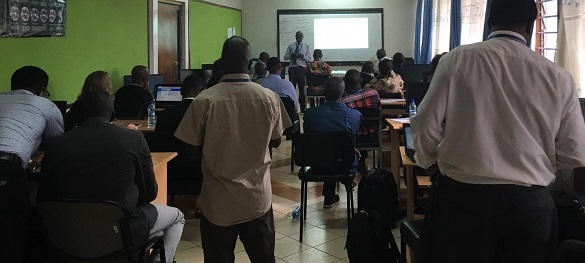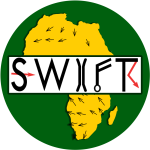In partnership between UK and African scientists, African SWIFT is testing new state of the art, weather forecasting methods in tropical Africa. These methods have the potential to save lives and mitigate the economic damage caused by severe weather events.
During the two weeks, 23 April-6 May, a team of GCRF African SWIFT researchers and operational forecasters met in Nairobi, Kenya to conduct a weather forecasting testbed. Hosted by SWIFT partners, the Kenya Meteorological Agency (KMD), the testbed brought together researchers and operational forecasters from across West and East Africa, to engage in the developmental testing of forecasting systems in a quasi-operational environment. 
Teams created forecasts, testing in real time current forecasting and “nowcasting” capability, as well as newly proposed methods, with the aim to gain insight into the issues faced in producing and delivering forecasts, and to work to improve both forecasts and their delivery to user groups in Africa. The teams tested new methods, highlighted areas for improvement in the methods currently used, and developed closer working relationships between the academic and operational forecaster communities and forecast user groups. Following on from the testbed, African and UK scientists are working together to develop and put into place further improvements to the forecasting and nowcasting systems, and evaluate their benefits for users of the forecasts.The scientific focus of the SWIFT testbed is the integration of research and operational practice in the area of synoptic weather forecasting and nowcasting.
The African SWIFT Testbed aims to advance forecasting science and to bring about step changes to the delivery of forecasting in Africa in three key areas:
Nowcasting: Many of the forecasting products or tools developed by meteorologists have, to date, focused largely on European weather systems and consequently have been of limited use to forecasters in Africa. The SWIFT testbed set out to evaluate a set of these products, the NWC SAF Nowcasting software, to determine how the tools can be adapted to African weather systems, and so advance forecasting techniques in Africa. Teams of scientists considered factors such as temperature thresholds and time-ranges, to determine how these can be adapted to work with African weather features and dynamics, and so advance forecasting capability. 
During the two weeks, testbed teams, for the first time in Africa, tested and evaluated convection permitting ensemble (CP ensemble) forecasting. They used a set of models, designed by SWIFT partners at the UK Met Office specifically for the Testbed, to provide measures of confidence in the accuracy of forecasts of storms. CP ensembles have been used for several years now, in the UK and elsewhere, to improve forecast confidence, but so far they have not been used in African weather forecasting. Convective storms are highly chaotic, and it is very hard to have confidence in the results of a single forecast. An ensemble model provides the forecaster with several forecasts of the same event, from which they can judge how likely that event may be. It is during the SWIFT testbeds that these ensemble models were used in Africa for the first time. Given the high incidence of convective storms in Africa, and the severity of many of those storms, the addition of ensemble models to the range of tools available to African forecasters, introduces the potential for a step change improvement in forecasting confidence across the continent.
During the testbed, the Nairobi teams engaged directly with African forecast user groups at a Users’ Forum that ran at the same time as the testbed. The workshop was organised by SWIFT and KMD in partnership with the ForPAc project. Stakeholders representing different forecast user groups and economic sectors, such as the Red Cross, farming and fishing communities, water resources agencies, and the oil and gas industry, took part. Users were given the opportunity to view real-time forecasts produced by the testbed teams, using newly developed visualisation tools, and to feedback their impressions. The testbed teams created bespoke forecasts for the user groups, who each require forecasts based on different geographical areas and timescales. As well as forecasts based on different areas and timescales, the testbed also looked at adapting their forecasts for the different user groups by using different delivery methods such as text bulletin, numerical forecasts etc. A major effort in the testbed was to conduct systematic evaluation of the forecasts. This included evaluation of the quantitative information in a forecast, such as the timing and location of rainfall, as well evaluating the usefulness of forecasts for the users.
A major effort in the testbed was to conduct systematic evaluation of the forecasts. This included evaluation of the quantitative information in a forecast, such as the timing and location of rainfall, as well evaluating the usefulness of forecasts for the users.
African SWIFT Principal Investigator Professor Doug Parker comments, “Africa experiences some of the most intense storms on planet Earth, and these storms are increasing in intensity due to climate change. Meteorologists have developed new methods to observe and predict these storms, and to provide warnings which can help people to take action. We are very excited to be trialing some of these methods for the first time in Africa.”
Organisations involved in the testbed include:
- African Centre of Meteorological Applications for Development (ACMAD), Niger
- Agence Nationale de l’Aviation Civile et de la Meteorologie (ANACIM), Senegal
- Ecole Panafricane de Météorologie et d’Aviation Civile (EAMAC) http://www.eamac.ne/EAMAC
- Federal University of Technology Akure (FUTA), Nigeria
- Towards Forecast-based Preparedness Action (ForPAc), Kenya (funded by the UK’s NERC/DFID through the ‘Science for Humanitarian Emergencies and Resilience’ (SHEAR) Research Programme
- Ghana Meteorological Agency (GMet)
- Kenya Meteorological Department (KMD)
- IMTR-Nairobi, Kenya
- Kwame Nkrumah University of Science and Technology (KNUST), Ghana
- National Centre for Atmospheric Sciences (NCAS), UK
- Nigerian Meteorological Agency (NiMet), Nigeria
- UK Met Office
- University of Leeds, UK
- University of Reading, UK
- Université Cheikh Anta Diop (UCAD), Senegal
- University of Nairobi, Kenya
- South Sudan Meteorological Department
- Tanzania Meteorological Agency
- Uganda National Meteorological Authority (UNMA)
- WMO RTC, Lagos, Nigeria
More testbed news coverage:
